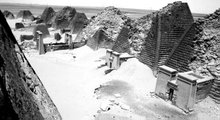 We recently visited the pyramids of Meroe - it was the first time since my arrival here that I had visited an official tourist site. Despite what the guidebook stated, we did not have the grounds to ourselves and we shared the experience with some visiting Chinese businessmen. They pyramids are said to be the most visited site in all of Sudan – we saw a half dozen people, all of them Chinese. The touts that lined up outside the derelict entrance gates had only a half-dozen trinkets each displayed on the sand before them. Besides the miniature pyramids and Darfuri knives, the remaining baubles – cheap elastic and fake silver jewelry – I assume also came from China. It was strange to see a Chinese person bargain over them.
We recently visited the pyramids of Meroe - it was the first time since my arrival here that I had visited an official tourist site. Despite what the guidebook stated, we did not have the grounds to ourselves and we shared the experience with some visiting Chinese businessmen. They pyramids are said to be the most visited site in all of Sudan – we saw a half dozen people, all of them Chinese. The touts that lined up outside the derelict entrance gates had only a half-dozen trinkets each displayed on the sand before them. Besides the miniature pyramids and Darfuri knives, the remaining baubles – cheap elastic and fake silver jewelry – I assume also came from China. It was strange to see a Chinese person bargain over them. The ruins are the graves of ancient Meroe royalty, and date from around 0 AD. Most have been destroyed over the years - either through the effects of time or through pillaging by treasure hunters like the Italian Giuseppi Ferlini, who disassembled many of them piece by piece in search of gold and found nothing more than one necklace. In any case, not enough about them is known, and the bits and pieces that have been picked up over the years have left Sudan and now lie in European museums. What is left of interest are 2000-year old hieroglyphics alongside modern 20th century graffiti: "Osman Mahd, 1946"; "Alman, 1950"; "Latio, 1950."
It is remarkable what Sudan has to offer to visitors: the best diving in the world along the Red Sea Coast, a history as ancient as that of Egypt’s, the mountains and waterfalls of Jebel Mara in West Darfur (which used to be a popular R&R destination), a total geographical area almost five times as large as Kenya including an environment in the south that once supported the same populations of wild animals that brings Kenya over half of a billion USD every year in tourism revenue, and a hospitality of a people that is legendary among even well-traveled backpackers.
Instead, Sudan decides to throw this away, and instead spend much of its time destroying itself through everlasting war.


